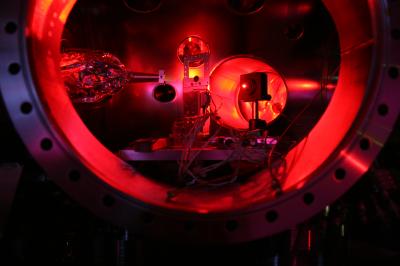X-ray laser simulates the 2-million-degree heart of a star
January 26, 2012

Linac Coherent Light Source SXR experimental chamber. The central part of the frame contains the holder for the material that will be converted by the powerful LCLS laser into hot, dense matter. To the left is an XUV spectrometer and to the right is a small red laser set up for alignment and positioning. (Credit: University of Oxford/Sam Vinko)
SLAC National Accelerator Laboratory researchers have used the world’s most powerful X-ray laser to create and probe a 2-million-degree piece of matter in a controlled way for the first time.
This feat takes scientists a significant step forward in understanding the most extreme matter found in the hearts of stars and giant planets, and could help experiments aimed at recreating the nuclear fusion process that powers the sun.
SLAC’s Linac Coherent Light Source (LCLS) rapid-fire laser pulses are a billion times brighter than those of any X-ray source before it. Scientists used those pulses to flash-heat a tiny piece of aluminum foil less than a trillionth of a second, creating what is known as “hot dense matter,” at a temperature of about 2 million degrees Celsius.
“Making extremely hot, dense matter is important scientifically if we are ultimately to understand the conditions that exist inside stars and at the center of giant planets within our own solar system and beyond,” said Sam Vinko, a postdoctoral researcher at Oxford University and the paper’s lead author.
Scientists have long been able to create plasma from gases and study it with conventional lasers, said co-author Bob Nagler of SLAC, an LCLS instrument scientist. But no tools were available for doing the same at solid densities that cannot be penetrated by conventional laser beams.
The measurements will feed back into theories and computer simulations of how hot, dense matter behaves and could help scientists analyze and recreate the nuclear fusion process that powers the sun.
Ref.: S. M. Vinko, et al., Creation and diagnosis of a solid-density plasma with an X-ray free-electron laser, Nature, 2012; [DOI:10.1038/nature10746]